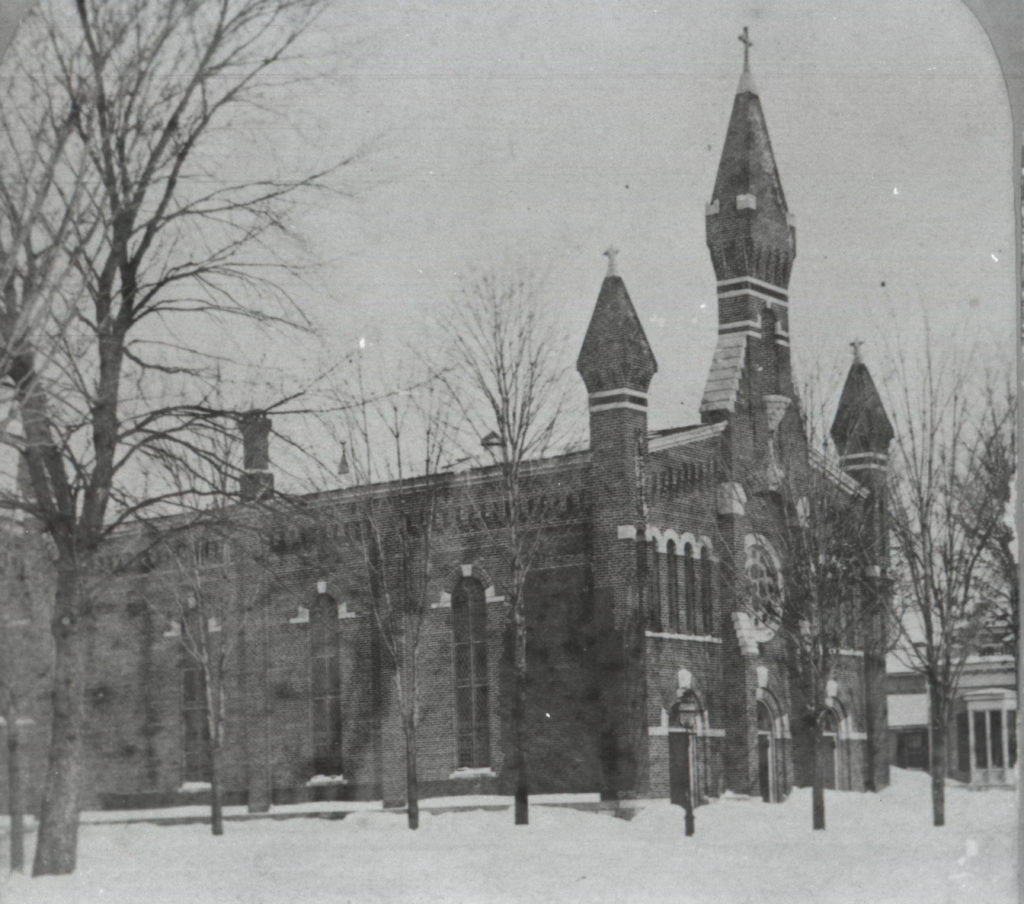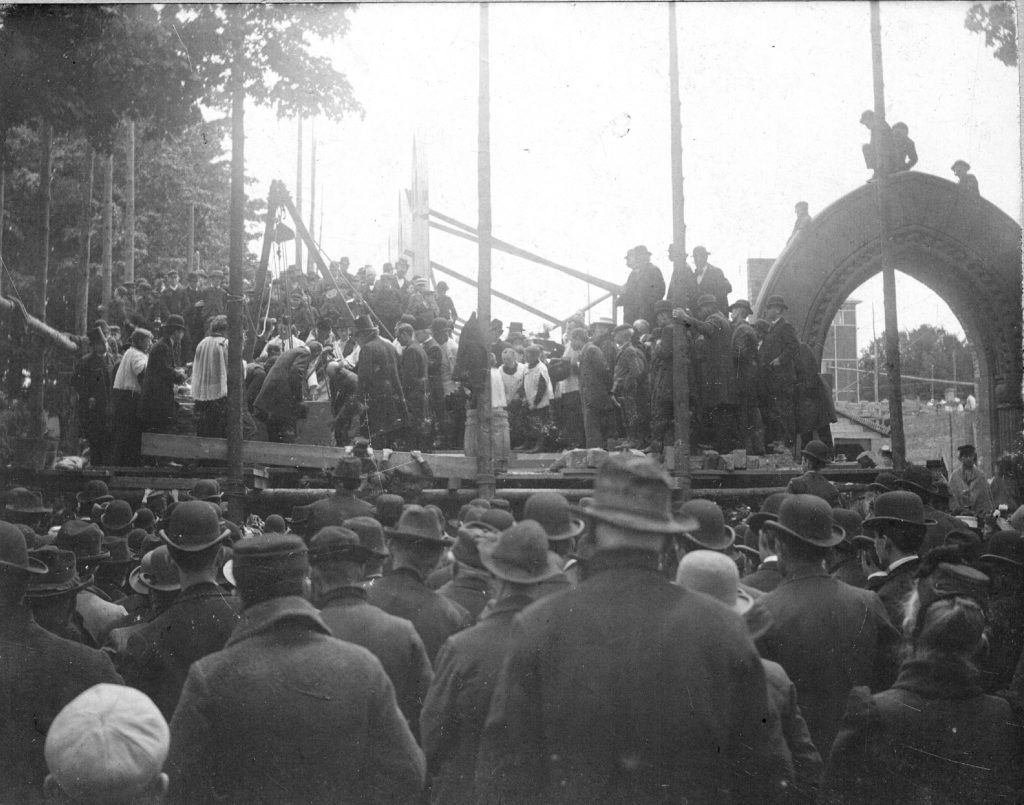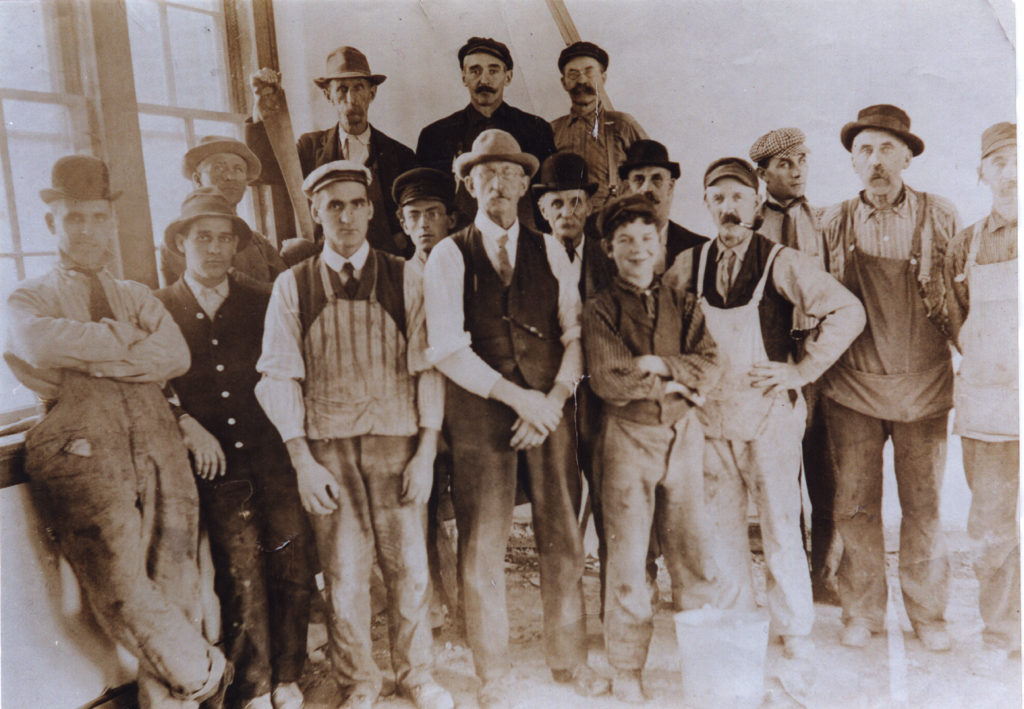St Peters History 2
ST. PETER’S CHURCH
1837 – 1997
It all began in the year 1803, where in Drummond, Queens County, Ireland, the founder and first pastor of our church, William Beecham was born. His parents, suprisingly, were Episcopalians but joined the Catholic Church when William entered the famed Carlow College, Dublin. Upon graduation he left for America, arriving at the Port of New York in late November 1836. On December 9, he was ordained by Bishop John DuBois in “Old St Patrick’s Cathedral” in New York City. On December 23, of this same year, he was assigned to St John’s in Utica NY and was given the awesome responsibility as a true missionary embracing no less than thirteen counties in New York State. Considering the vastness of this region, Father Beecham chose Rome for its central location where he made his home on Dominick Street and his first church, an old cooper shop.
To say this incredibly large are under Father Beecham’s domain was wilderness would probably be an understatement. It was not unusual during winter journeys to find him under an overturned sleigh as a protection from the harsh environment, but it was never severe enough o daunt his courage, or was the distance ever too great to test his patience. These virtues and his fearlessness of being rebuked endeared him to all who knew him, commanding their respect and admiration. A hard and constant worker, new parishes and churches sprang up in his territory and priests were detailed to do duty I them, relieving him of much care and anxiety.

| Original St. Peter’s Church 1837 – 1897 Located on the site of the present St. Peter’s School Corner of Floyd Ave. and St. Peter’s Ave. |
Now his efforts could be centered on Rome where his parish grew rapidly. He felt it was time to build a new church, one of brick no less. This was no easy task; even his Bishop felt such a project preposterous, but with the backing of his growing parish who recognized his leadership and perseverance, our first church was built on the corner of Floyd Avenue and Spring Street.
When he arrived, there were just five members of his “parish”. When he died in 1876, after forty years of service to God and his congregation, St Peter’s had grown to four hundred families.
Also, from Ireland, in County Fermanagh, our second pastor, Aloysius Murphy was born in 1840. He came to America in 1866, and attended St Boneventure’s Seminary here in New York State. Like his predecessor, his ordination took place in St Patrick’s Cathedral in New York City. The year was 1871. He spent the next five years as assistant at St Mary’s church in Hudson NY, then pastor at Hunter, Greene County before coming to Rome in 1876. He immediately recognized the need to enlarge his church and just two years later enlisted the aid of an architect, G. Edward Cooper to determine the expansion necessary. The original costs were estimated by the contractor, Woodman Kimball of Rome, to be between eight and ten thousand dollars. The final cost however, of $15,000, was raised by subscription and the pastor, aided by the hearty cooperation of his congregation and friends.
Reverend Murphy’s attention was now directed to the burial grounds, two acres in East Rome donated by the Lynch estate in 1838 and whose plots were now greatly reduced after forty years of use. He purchased eight more acres adjoining these grounds, organized a cemetery association and with the aid of an engineer and several members of his congregation cleared and graded the entire area. Then, at a cost of $3,000, had a house built on the northwesterly corner for a caretaker.
Having been our pastor for less than eight years, Father Murphy decided to begin still another project, that of building a new rectory. His present home was, although constructed of brick, cold, damp and poorly constructed. It was also a constant expense to the parish. Architect Cooper was called and R. A. Putnam of Rome was given the contract. The completed building, with furnishings, was $14,000, but not a penny was asked in the way of a subscription. All the bills were paid from receipts from entertainments held during the progress and after the building of the residence. So pleased was Reverend Murphy, he was quoted to have said the following New Year’s Day: “…we have reason, both as a congregation and as individuals, to be thankful on this day. When we look back and review the work done, and find ourselves today with not one cent of indebtedness hanging over us we may well thank God, for He has indeed favored us with His blessing in our labor. All around us we find churches with heavy loads to carry. Some of these churches could be rebuilt for the indebtedness upon them. Let us then this day thank God for the abundant favors and blessings He has bestowed upon us.”
The success of Father Murphy’s labors up to this time was remarkable. In less than ten years he had an expenditure of $33,500 and a balance of $967! Still his parish continued to grow. The expansion of his present church seemed unfeasible, and then too, a school was needed. Now he felt the choice should be made by his congregation. At a meeting they suggested a new church should be built first and a school later. The decision was made and Father Murphy is quoted: “You have decided your course. I am heart and soul with you. It is your work but I will shoulder my share”. And that he did. In 1892 hr purchased property on the corner of James and E. Park St from M. M. Davis, then the Lenox residence adjoining same as well as Miss Helen Grady’s home in the rear. Finally, he enlisted the services of architect Archimedes Russell of Syracuse to draw up the plans for the new church. The contract for the foundation was given to W. J. Cramond of Rome. In the Spring of 1895, when the contracts for the completion of the church were given, Henry Ryan of Syracuse secured the mason work and Lawrence Carey of Rome, the carpenter contract.
| Laying of Cornerstone Viewed from North James St. Looking east Arch is North Door. |

On the 21st of May 1895 the cornerstone was laid. On October 24, 1897, and at a cost of $125,000, the new St Peter’s church was finished. The fact that it was the first church of this magnitude to be completed and consecrated the same day, being free of indebtedness, is still considered to this day one of the marvels of church history. Msgr. Martinelli, the papal delegate of Washington DC performed the Consecration ceremonies according to the Ritual of the Roman Catholic Church. The Consecration sermon as given by Msgr. Conaty of the Catholic University of America, Washington DC, and the evening sermon by Bishop McQuaid of Rochester.
| Builders of Our Church Brick layers, masons, carpenters and engineers. Wilton Monroe Davies, A carpenter, (man with pipe), Is the grandfather of one of our parishioners, Mr. E. Erwin Owen Jr. |

